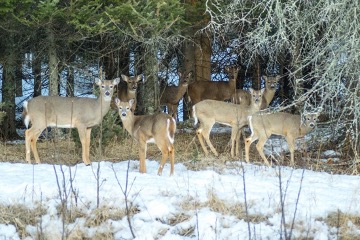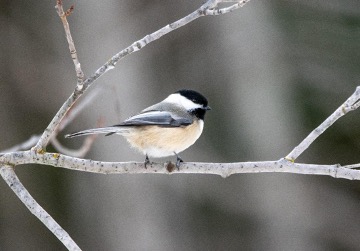For this month’s listicle, featuring park animals and their autumnal activities, I was lucky enough to connect with one of the Core Naturalists at the Carl W. Kroening Interpretive Center at North Mississippi Regional Park, Scarlet Fitzsimmons (Wickert). Scarlet compiled the following list of animals and their fall behaviors for this post. While her knowledge of these creatures extends well beyond this listicle, it is a magnificent start to a series we hope to continue in partnership with the Minneapolis Park and Recreation Board’s Core Naturalists program, highlighting the wonderful world of urban wildlife throughout the changing seasons.
For now, we’ll explore how Minneapolis’s urban wildlife is spending fall and gearing up for winter, through Scarlet’s list below. As Scarlet mentioned in our conversation, “We often encounter these species more during this time of year, as the world cools down and leaves fall from the trees, reducing their cover.”
#1. Gray squirrel (Sciurus carolinensis)

Neighborhood squirrels spend their fall preparing for winter by stockpiling resources and adding more insulating material to their nests. These critters can bury up to 50 nuts in an hour for future consumption. The nest of a squirrel is called a drey, and these structures often become more conspicuous as the leaves fall in autumn. Look out for them! These basketball-sized nests are found in the forks of trees and are usually composed of leaves, twigs, and grass.
#2. White-tailed deer (Odocoileus virginianus)

Throughout the autumn months, white-tailed deer increase their leaf and twig consumption before these food sources decline significantly in the winter. Less vegetation makes it even more difficult for deer to hide, so they naturally begin to encroach on human land, primarily at dawn and dusk. This makes fall a great time to spot deer in parks and outdoor areas.
#3. Black-capped Chickadee (Poecile atricapillus)

Much like mammals, chickadees are trying to get the last of many seasonal resources — like fruit, insects, and green plant matter. Chickadees are one of the few birds we can see on our feeders year-round, and for good reason. In Minnesota, they rely on human food offerings significantly, with residential bird feeders supporting a large portion of the population. In fact, research has shown that chickadees in Minnesota with access to a feeder are twice as likely to survive the fall and winter seasons. You can support chickadee populations by providing black-oil sunflower seeds, suet, or a nesting box.
[Related Content: Five Parks to Catch Sight of Winter Birds]
#4. Bald eagle (Haliaeetus leucocephalus)

Often, we think of fall as a time where birds migrate, but that is not the case for every species. Minnesota has the third largest bald eagle population in the country (trailing only behind Alaska and Florida), and this is because they rely on abundant lakes and rivers filled with fish. Most bald eagles will stay close to the waters they call home if weather permits, and their water sources don’t freeze over. Only when these water sources start to freeze will they migrate, with some birds simply moving to southern Minnesota, and others flying south across the country. Still, bald eagles will experience other changes in behavior during the fall. Most bald eagles will begin to live more communally to share food and warmth, look for food in more coniferous woodlands as deciduous trees drop their leaves, and of course eat more to sustain themselves during the cooler temperatures.
Garter Snake (Thamnophis sirtalis)

Garter snakes are one of the few snakes seen often by people in Minnesota because they are diurnal, or active during the day, instead of being nocturnal like most other snakes. However, soon we will cease to see them until spring. Unlike the birds and mammals listed above, reptiles are cold-blooded, meaning they need to seek out external sources of heat (usually the sun) to regulate their body temperature. Once the temperatures drop below 68 degrees Fahrenheit, garter snakes enter the reptile equivalent of hibernation, which is called brumation. During brumation, garter snakes are awake, but extremely inactive and they may not eat, drink, or move for weeks at a time. Garter snakes are actually one of the few species that brumate communally in groups called aggregations. These aggregations of several hundred snakes brumate in the burrows of other animals, mud banks, rock walls, and areas under logs. Like clockwork, garter snakes will be the first snakes visible in spring, when the average temperatures begin to consistently get above 68 degrees Fahrenheit. Most other reptiles and amphibians, including turtles, frogs, and salamanders will also be entering brumation during late fall.
Check out the Kroening Interpretive Center for more, related information:
The Kroening Interpretive Center is a nature center located within North Mississippi Regional Park. It is free to visit and open year-round. It has a new interactive exhibit that connects visitors to the urban wildlife you might find in your neighborhood and the animals that use the Mississippi River as a corridor through Minneapolis. It hosts groups of all types – including school groups, toddlers, and family groups! It also rents out binoculars, bug nets, and other nature exploration tools. Outside of the center, North Mississippi Regional Park has a new nature playground, opened in 2021 thanks in part to support from People for Parks, now part of the Minneapolis Parks Foundation, a restored prairie, and interpretive signs around the park!
Featured image courtesy of Minneapolis Park and Recreation Board.

